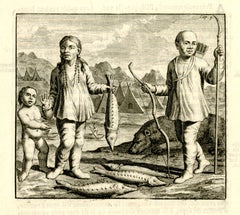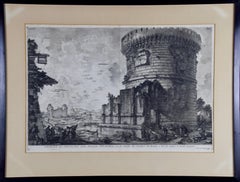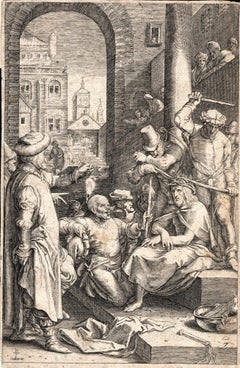Cornelis de Bruijn Landscape Prints
to
1
Overall Width
to
Overall Height
to
1
2
169
158
146
131
1
1
1
1
1
1
1
1
1
1
1
1
1
Artist: Cornelis de Bruijn
Ostiakes
By Cornelis de Bruijn
Located in Fairlawn, OH
Ostiakes
Engraving, 1718
From: Voyages de Corneille le Brun par la Moscovie, en Perse, et aux Indes Occidentales (French translation, 1718), Chapter XXI
The Ostyak are a member of an...
Category
1710s Old Masters Cornelis de Bruijn Landscape Prints
Materials
Engraving
Related Items
Ancient Roman Architecture: Original Framed 18th C. Etching by G. Piranesi
By Giovanni Battista Piranesi
Located in Alamo, CA
"Veduta del Sepolcro della Famiglia Plauzia per la Strada Che Conduce da Roma a Tivoli vicino a Ponte Lugano" from "Le Antichità Romane" (Roman Antiquities), one of the most famous works by Piranesi. "Antichita" illustrates the tombs along the Appian Way...
Category
Early 18th Century Old Masters Cornelis de Bruijn Landscape Prints
Materials
Etching, Engraving, Drypoint
$3,875
H 24.38 in W 31.75 in D 0.75 in
Christ Crowned with Thorns, from The Passion of Christ
By Hendrick Goltzius
Located in Middletown, NY
Engraving on cream wove paper, 8 x 5 3/8 inches (203 x 137 mm), narrow to thread margins. First state (of 2). A fine impression with archival paper adhered at left top and bottom cor...
Category
Early 17th Century Old Masters Cornelis de Bruijn Landscape Prints
Materials
Engraving
Fountains of Rome; Fontana e castello dell'Acqua
By Giovan Battista Falda
Located in Middletown, NY
Rome: Giovanni Giacomo De Rossi, 1625.
Etching and engraving on cream laid paper, 8 3/8 x 11 1/4 inches (222 x 286 mm), full margins. In good condition with some light yellow discoloration in the margins and on the verso, the image area remains clean and bright. The inscription in the lower margin reads Paulus Quintus Pont. Maxim ... anno DNI MDCXII Pontif.s sui Septimo' and in the margin 'Fontana e castello dell'acqua Paola a S.Pietro Montorio sul Gianicolo, condotta da Paolo V, vicino a Bracciano, Architett.a di Giovanni Fontana', and signed at left 'G.B.Falda del. et inc.' and at right 'G.Iac.Rossi le stampa in Roma alla pace co priv. del SP', and the number '11' in the lower right corner. Printed in 1691.
[Bartsch/Le Pientre graveur XXI.241.13]
Book I, plate 11: Fountain of San Pietro in Montorio, from "Le fontane delle ville di Frascati nel Tusculano con li loro prospetti" ("The fountains of the Villas of Frascati in Tusculano and their prospects"); a set of four books on fountains published by Giovanni Giacomo De Rossi (Italian, Rome 1627–1691), after Giovanni Francesco Venturini (active ca. 1650–1700) and Giovanni Battista Falda...
Category
Early 17th Century Old Masters Cornelis de Bruijn Landscape Prints
Materials
Laid Paper, Engraving, Etching
Fountains of Rome
By Giovan Battista Falda
Located in Middletown, NY
A charming scene with romping dogs and spectators watching the cascading water play a trick on an unsuspecting man who is sprayed as he descends the steps, ...
Category
Early 17th Century Old Masters Cornelis de Bruijn Landscape Prints
Materials
Laid Paper, Engraving, Etching
St Peters Church at Rome /// "Vitruvius Britannicus" Architecture Engraving Art
By Colen Campbell
Located in Saint Augustine, FL
Artist: Colen Campbell (Scottish, 1676-1729)
Title: "St Peters Church at Rome" (Vol. 1, Plate 6)
Portfolio: Vitruvius Britannicus; or The British Architect, Containing the Plans, Ele...
Category
1710s Old Masters Cornelis de Bruijn Landscape Prints
Materials
Laid Paper, Engraving, Etching, Intaglio
The Last Supper, from The Passion of Christ
By Hendrick Goltzius
Located in Middletown, NY
Engraving on cream laid paper, 8 x 5 3/8 inches (203 x 137 mm), trimmed at the platemark. A fine impression with a Coat of Arms watermark. Second state, after the addition of the Frederick de Witt...
Category
16th Century Old Masters Cornelis de Bruijn Landscape Prints
Materials
Engraving, Laid Paper
The Queen of Great Britain arriving in Portsmouth 25 May 1662 & The Arrival in L
By Matthäus Merian the Elder
Located in Middletown, NY
Two images of Queen Catharina of Braganza; one before her marriage to King Charles II, the other after, as Queen of Great Britian. Engraved by Matthiäus Merian, father of Maria Sybli...
Category
Mid-17th Century Old Masters Cornelis de Bruijn Landscape Prints
Materials
Laid Paper, Engraving
The Beheading of the King of England; Enthauptung des Königs in England
By Matthäus Merian the Elder
Located in Middletown, NY
The execution of Charles I (1600-1649) at Whitehall, January 30th 1649, in front of the Banqueting House. The executioner holding the head of Charles up to the crowd below.
Engravin...
Category
Mid-17th Century Old Masters Cornelis de Bruijn Landscape Prints
Materials
Engraving, Laid Paper
Le Tour de Clermont en Dauphine apartenant a Monsieur de Tonnerre
By Israel Silvestre
Located in Middletown, NY
Etching and engraving on handmade cream laid paper, 3 7/8 x 6 7/8 inches (97 x 173 mm), full margins. In good condition, consistent with age. Several small notations in pencil in t...
Category
18th Century Old Masters Cornelis de Bruijn Landscape Prints
Materials
Handmade Paper, Laid Paper, Engraving, Etching
$400
H 7.88 in W 6.88 in
Venus Lamenting over the Death of Adonis
By Herman van Swanevelt
Located in Middletown, NY
c. 1654. Etching with engraving on thin laid paper with an early and large unidentified watermark with a sundial and a many-pointed star, and an unidentified collector's stamp in the...
Category
Mid-17th Century Old Masters Cornelis de Bruijn Landscape Prints
Materials
Handmade Paper, Engraving, Etching
Set of Four Engravings from Nash's "History of Worcestershire" /// Landscape Art
By Treadway Russell Nash
Located in Saint Augustine, FL
Artist: Treadway Russell Nash (English, 1724-1811)
Title: "A View of Stourbridge", "A View of Upton upon Severn, from Ryal Hill", "Bewdley", and "Tenbury"
Portfolio: Collections for the History of Worcestershire
Year: 1781-1782 (First edition)
Medium: Set of Four Original Engravings on watermarked laid paper
Limited edition: Unknown
Printer: John Nichols, London, UK
Publisher: T. Payne and Son, J. Robson, B. White, Leigh and Sotheby, London, UK; Fletcher, Oxford, UK; and Lewis, Worcester, UK
Reference: Upcott III, page 1330
Sheet size (each): approx. 10" x 16.5"
Image size (each): approx. 6.88" x 11.75"
Condition: A few light handling creases. Have been professionally stored away for decades. They are all strong impressions in excellent condition
Notes:
Provenance: private collection - Aspen, CO. All four works were engraved by English artist Thomas Sanders (Active: Mid-Late 18th Century) after drawings by himself. Comes from Nash's two volume "Collections for the History of Worcestershire", (1781-1782) (First edition), which consists of 75 engravings. Each work is printed from one copper plate in one color: black. There was a (Second edition) "with Additions" bound in with Volume II of this portfolio published by John White in 1799. And, both the First and Second editions of "Collections for the History of Worcestershire" are based off Thomas Sanders' 1779-1781 "Perspective Views of the Market Towns within the County of Worcester". Both "A View of Stourbridge" and "A View of Upton upon Severn, from Ryal Hill" have unidentified fleur-de-lis watermarks in the center of their sheets. "Bewdley" has an unidentified watermark in the center of its sheet resembling "XV" and "Tenbury" has no watermark.
Biography:
Treadway Russell Nash (24 June 1724 – 26 January 1811) was an English clergyman, now known as an early historian of Worcestershire and the author of Collections for the History of Worcestershire, an important source document for Worcestershire county histories. He was a fellow of the Society of Antiquaries of London.
Treadway Russell Nash was born on 24 June 1724 born at Clerkenleap, in Kempsey, Worcestershire. His family were from Ombersley. They had lands there and at Claines, and had later bought lands in the Reformation around St Peter's, Droitwich. He was related to James Nash and John Nash, both MPs for Worcester. His father Richard, a grandson of Sir Rowland Berkeley, died in 1740, and Richard's eldest son in 1757. As a result, Treadway Russell Nash inherited the Russells' Strensham estates from his brother, as well as the Nash estates, and took both names.
He was educated from the age of twelve at King's School, Worcester, and became a scholar at Worcester College, Oxford aged fifteen. In March 1749, he accompanied his brother on a trip to the continent, to aid Richard's health. They visited Paris for about six weeks, before spending the summer "on the banks of the Loire". They then visited "Bourdeaux, Thoulouse, Montpelier, Marseilles, Leghorn, Florence, Rome, Naples, Bologna, Venice, Padua, Verona, Milan, Lyons, and again Paris"; such expeditions are often known as the Grand Tour.
On his return in late summer 1751, Nash took up a post as Vicar of Eynsham through his friend and future brother-in-law, John Martin. He also had an income as a tutor at Oxford. He took his Doctor of Divinity degree and left Oxford, having "gone out grand compounder", following the death of his brother. He also left his benefice at Eynsham in 1757. While at Oxford he had proposed a road from there to Witney (now the A40 and B4022), and also stood for Parliament. Nash married Margaret Martin...
Category
1780s Old Masters Cornelis de Bruijn Landscape Prints
Materials
Laid Paper, Engraving
Chateau de Verneuil
By Matthäus Merian the Elder
Located in Middletown, NY
Engraving with hand coloring and heightening in watercolor on two leaves of expertly conjoined handmade laid paper, one leaf with a large watermark a feathered dragon, 7 1/4 x 11 1/4...
Category
Mid-17th Century Old Masters Cornelis de Bruijn Landscape Prints
Materials
Watercolor, Handmade Paper, Engraving
Cornelis De Bruijn landscape prints for sale on 1stDibs.
Find a wide variety of authentic Cornelis de Bruijn landscape prints available for sale on 1stDibs. You can also browse by medium to find art by Cornelis de Bruijn in engraving and more. Much of the original work by this artist or collective was created during the 18th century and is mostly associated with the Old Masters style. Not every interior allows for large Cornelis de Bruijn landscape prints, so small editions measuring 7 inches across are available. Customers who are interested in this artist might also find the work of Colen Campbell, Ludovico Caracciolo, and Charles Amand Durand. Cornelis de Bruijn landscape prints prices can differ depending upon medium, time period and other attributes. On 1stDibs, the price for these items starts at $300 and tops out at $300, while the average work can sell for $300.


